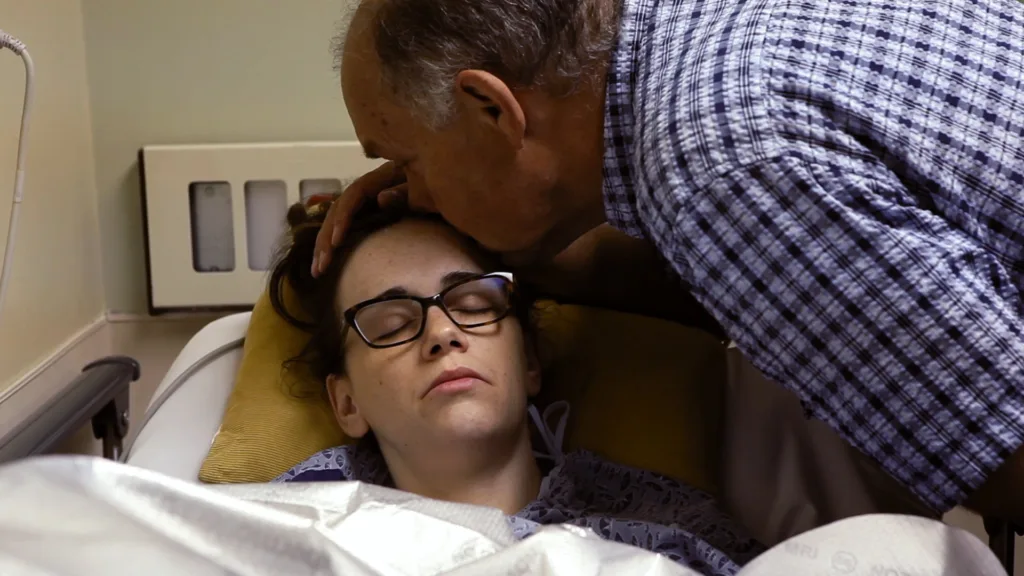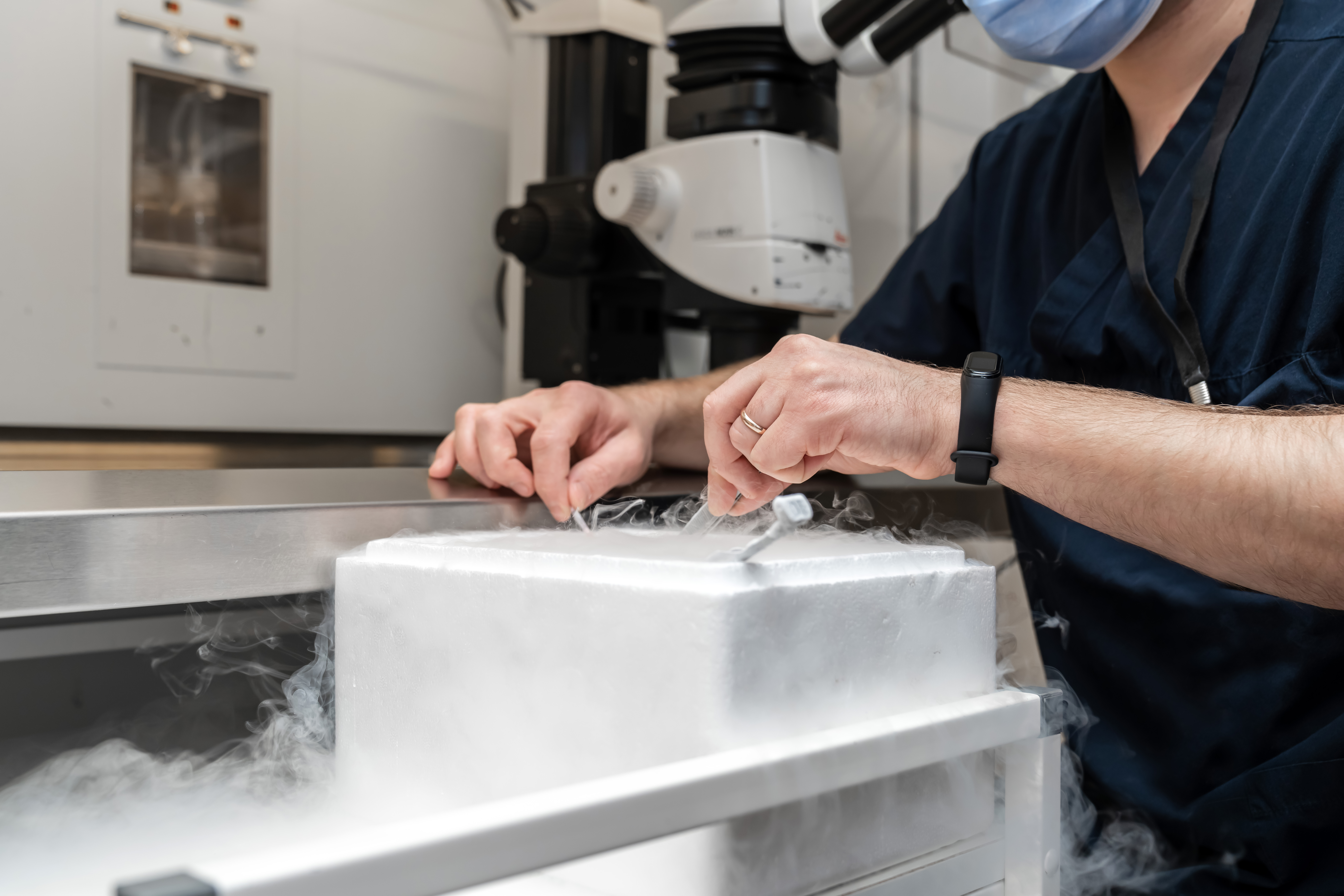I have never known anyone who had endometriosis, but I have recently grown more aware of this devastating disease as I learn more about women’s health and fertility. I am not the only one. The newly released Below the Belt documentary presents a picture of endometriosis for people who, like me, may not know much about it or have no idea what it is.
The film begins as director Shannon Cohn describes how she first experienced symptoms of endometriosis at 16 years old. Sadly, Cohn went undiagnosed for 13 years. As the film unfolds, we learn that her story is not unusual. Most women with endometriosis suffer for many years before understanding why. Awareness of this distressing phenomenon is the main goal of the documentary. Despite the fact that endometriosis is a real problem affecting millions of women all over the world, knowledge about it is severely lacking, even–and especially–in the medical community. Projects like Below the Belt hope to change that.
What I liked about Below the Belt
Takeaway #1: Most endometriosis medications, including hormonal birth control, only mask the symptoms
The “main characters” of Below the Belt are four women of different races and ages. The film follows each woman to some resolution of her endometriosis journey. Three receive symptom relief through excision surgery, and one successfully conceives and gives birth to a healthy baby.
One of the things I really appreciated about Below the Belt was the light shed on the use of various drugs to treat endometriosis, particularly hormonal birth control. This was particularly chilling in the story of Laura, one of the women who eventually ended up receiving excision surgery (and later, she also received a hysterectomy because of adenomyosis). Having been on various oral contraceptives and other drugs since she was 12 years old, she says sadly to the camera that it’s been “one big chemical overload… My body’s never had a break.” In the next scene, she is lying face down on the floor. The viewer watches her body twitching from that “chemical overload,” although she had merely taken her routine prescribed medications for the day.
Emily, the youngest of the four women, started to have severe osteoporosis due to another strong hormonal drug that she had been prescribed. Other women mention that they have been prescribed 30 different kinds of oral contraceptives. Over and over in the film, attention is drawn to the reality that prescription drugs are routinely prescribed as a “treatment” for endometriosis. Unfortunately, by and large, they only mask or suppress its symptoms, often with drastic physical effects due to prolonged use.
Takeaway #2: Endometriosis usually elicits some type of grieving process
I also loved how Below the Belt tenderly addressed the reality of infertility. Kyung, an artist, describes the lack of motherhood as a “weight,” a theme often depicted in her artwork. At one point in the movie, she and her husband are overjoyed to receive a positive pregnancy test, particularly as she had been told that she would never get pregnant. Sadly, she loses the baby, and the audience is allowed to grieve with her since we followed her journey from positive test, through normal ultrasound, to loss.
We also grieve with Laura when we find out, after her excision surgery, that her uterus had to be removed as well due to her adenomyosis. Her hope to have her own biological children is dashed, and the audience is given the opportunity to mourn that loss with her.
Likewise, we receive some closure when we find out at the end of the documentary that Kyung is able to have a healthy baby, and Laura has healed enough to go back to her work with infant massage. The loss of motherhood is not one often grieved in our culture–instead, it is often celebrated–but Below the Belt gives us an honest, poignant portrayal of the emotional depths of that loss.
What I disliked about Below the Belt
Takeaway #3: ‘Endometriosis’ isn’t clearly defined
While the director made a disclaimer at the beginning of Below the Belt that not all aspects of endometriosis would be covered, I still found myself wishing that this film did more to define endometriosis and the hallmarks of the disease. For instance, there is not much background given about the disease of endometriosis itself. My husband, who was watching the film with me, turned to me at one point and said, “So what exactly is endometriosis?” His knowledge of female health and fertility is growing, like mine, and he often learns from what I share with him. I realized with his question that endometriosis had not been clearly defined in the movie.
At one point in the documentary, a woman read a brief definition of endometriosis, but perhaps this would have registered more if one of the doctors who was interviewed gave a definition and history of it. I found myself wondering similar questions–what is the cause of endometriosis? Does anyone even know? Is endo preventable? Are certain women more susceptible than others, and if so, why? All of these questions went unanswered. Without some sort of nod to these natural queries, the female viewer is left to wonder if herself or her children, friends, or relatives will be hit unexpectedly with this disease that seems so debilitating.
Takeaway #4: No explanation for why excision surgery is the best treatment option
On a related note, I wish that Below the Belt made more mention of effective treatment other than (or in addition to) excision surgery. Three of the four women profiled in the documentary received excision surgery to remove the endometriosis in their abdomens. Surgery greatly relieved their symptoms and improved their quality of life. One woman, Jenneh, had also previously received ablation surgery, where the tissue is cauterized rather than removed, without success. And of course, all of them were prescribed various medications.
Excision surgery is quite effective, but it’s also very expensive and often not covered by insurance, as the film mentions. But what treatment options are there for low-income women? What about those who do not have access to a surgeon who is trained and comfortable with excision surgery? The answer offered in the movie is that increased funding for endometriosis research and increased education are needed. While I don’t doubt this, these things will obviously take time. I would have liked to learn what options exist (if any) beyond surgery and birth control that are readily available to women who are suffering now.
Takeaway #5: A missed opportunity to educate women on good nutrition and healthy lifestyles for endometriosis treatment and (possible) prevention
In doing some digging into the matter myself, I’ve learned that good nutrition may help mitigate endometriosis, and possibly help prevent the disease altogether–which, unfortunately, Below the Belt does not discuss.
For example, Fertility, Cycles, & Nutrition by the late Marilyn M. Shannon, highlights research on endometriosis prevention, including studies showing that higher levels of vitamin D and higher intake of dairy foods decrease risk of endometriosis [1]. Some research also suggests that higher intake of citrus fruits is associated with a lower risk of endometriosis [2]. Other research suggests the benefits of an anti-inflammatory, plant-based diet for women who already have endo [3].
For those women concerned about ways to live a healthy lifestyle that may either prevent endometriosis or help them deal with endometriosis symptoms when surgery isn’t an option, it would have been nice for Below the Belt to cover whatever research (no matter how little) is available on this subject.

What I disagreed with in Below the Belt
My final takeaway and last issue with Below the Belt has to do with the so-called “taboo” of endometriosis. The film observes that periods aren’t considered a polite conversation topic in public, and implies that increased societal openness about female reproduction would result in decreased time to endo diagnosis and better treatment options. But I’m skeptical of the claim that the problem is simply that people are skittish about saying words like “vagina” “uterus,” or “menstruation” out loud.
I believe the lack of knowledge about endometriosis and an unwillingness to dig down to its root causes is connected to some of the lies women have been told about what it means to be am empowered woman. Some strains of feminism taught that to be a truly free woman, you had to ignore or suppress those parts of you that were inherently female, like your ability to conceive and carry life. In other words, you had to become more “man-like” in order to achieve what men achieved. But in the process of becoming “as good as” men by suppressing what makes us distinctly female, women have become more and more divorced from their own bodies–especially their reproductive systems.
Rather than learning more about what it means to be a woman, and how to support our minds and bodies in healthy ways, many of us (and our doctors!) have simply suppressed our fertility with hormonal birth control. And for too long, we’ve accepted birth control as a Band-Aid for reproductive symptoms instead of pursuing root cause answers that preserve, protect, and heal our fertility. However, the tide may be changing on this, and Below the Belt may be right in this way about social taboos–women are increasingly discussing things like the necessity of healthy periods more openly, and demanding better solutions than birth control for their reproductive issues as a result.
Fertility appreciation education is needed
But the truth is, if we’re going to see real change in women’s health, we should also be discussing things like childbearing, fertility awareness methods (FAMs), and the negative effects of birth control more openly. Increased education on endometriosis is worthwhile and necessary, but how about we start at the beginning and educate our daughters about fertility awareness from the moment they have their first period? Not only will we catch any early symptoms of endometriosis, as Below the Belt hopes to achieve, but we will also teach our daughters to know what their bodies are capable of, and who they truly are as women.
References:
[1] Qiu, Yichao et al. “Vitamin D status in endometriosis: a systematic review and meta-analysis.” Archives of gynecology and obstetrics vol. 302,1 (2020): 141-152. doi:10.1007/s00404-020-05576-5 [2] Harris HR, Eke AC, Chavarro JE, Missmer SA. Fruit and vegetable consumption and risk of endometriosis. Hum Reprod. 2018 Apr 1;33(4):715-727. doi: 10.1093/humrep/dey014. PMID: 29401293; PMCID: PMC6018917. [3] Barnard ND, Holtz DN, Schmidt N, Kolipaka S, Hata E, Sutton M, Znayenko-Miller T, Hazen ND, Cobb C, Kahleova H. Nutrition in the prevention and treatment of endometriosis: A review. Front Nutr. 2023 Feb 17;10:1089891. doi: 10.3389/fnut.2023.1089891. PMID: 36875844; PMCID: PMC9983692.Additional Reading:
The Business of Birth Control: A Natural Womanhood Movie Review
Natural Womanhood Book Review: In the Flo by Alissa Vitti







